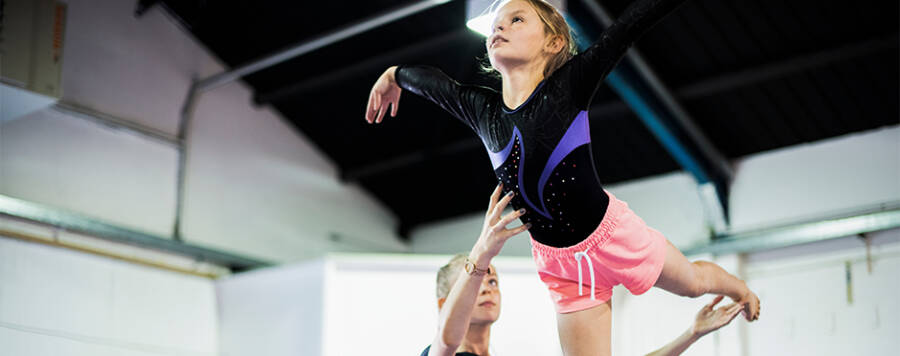The spotter is usually a coach or teammate who works to make sure tumbling skills are performed safely. For many coaches, the ratio of athletes to coach is such that they can be performing many repetitions of the same movement during a single practice. This can place added stress and increase the risk of injury to the spotter’s shoulder, wrist and low back.
Role of the Spotter
The role of a spotter during a tumbling skill is to protect the athlete performing the skill. They are there for safety. A spotter can provide minimal support or can be in contact with the athlete the entire duration the athlete is in the air doing a skill. The spotter helps to keep the tumbler safe so they can concentrate on the technique of the skill they are performing.
Protect the Wrists
When performing a spot, such as a bump spot, it is important to protect your wrist. A common mistake a spotter can make is to try to accept the weight of the tumbling athlete over their hand and wrist. To protect the wrist when spotting, they should use the forearm instead. The spotter should attempt to move the athlete’s weight more toward their elbow and use the strength of their shoulder to protect the wrist. It doesn’t matter how small or lightweight the athlete is, the spotter should always try to use the forearm instead of the hand and fingers during the spot.
Protect the Shoulders
When performing a spot, the shoulders are at risk of injury from accepting the weight of the athlete and overuse from repetitions. When spotting the athlete, the spotter should pay attention to their own shoulders to prevent them from moving up near their ears. The shoulder blades should feel like they are squeezing together and downward even while the arms are lifting or supporting the athlete.
Protect the Low Back
When spotting, as with lifting, your support should come from the legs instead of the back. Spotters should stand with feet wide apart and use their legs to squat and accept the weight of the tumbler. Then if the tumbler needs assist on height during their skill, the spotter can lift using their legs rather than torqueing the low back to help the athlete gain height.
The spotter should also keep their back straight and avoid standing with a hunched over position, which puts additional strain on the low back.
Additional Tips
- Limit reps! Spotters that are coming back from an injury or are feeling pain anywhere should limit the number of spotting repetitions performed. This may require additional staff at practices.
- Ensure spotters and athletes have good communication so the spotter is ready for the athlete to begin the skill to avoid injury from unexpected movements.
- Spotters should have a good core and upper/lower extremity exercise program to build/maintain strength and minimize the risk of overuse injuries from occurring.
- Don’t risk injury! If a spotter is feeling soreness or pain anywhere, stop spotting for the day and contact Athletico for a free assessment. The Athletico team will take a look at your pain or soreness complaint and provide recommendations for treatment.
The Athletico blog is an educational resource written by Athletico employees. Athletico bloggers are licensed professionals who abide by the code of ethics outlined by their respective professional associations. The content published in blog posts represents the opinion of the individual author based on their expertise and experience. The content provided in this blog is for informational purposes only, does not constitute medical advice and should not be relied on for making personal health decisions.
About the Author:
Tara Hackney, a physical therapist in Marion, IA, enjoys working with all patient types, especially gymnasts, cheerleaders, and dancers. She is the prominent blogger for Athletico's Gymnastic/Cheer Program. With an orthopedic specialization and training in dry needling and Graston technique, Tara hopes to answer your questions about injuries and injury prevention in an easy-to-understand manner. She hopes to ease fears surrounding pain and injuries, address concerns about recovery, and provide tips to prevent injury. In her free time, she enjoys spending time with her dog, reading, and watching her nephews play sports.

 width="900"
height="356"
>
width="900"
height="356"
>
